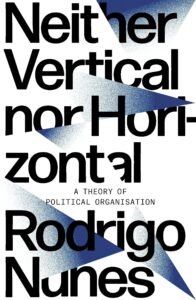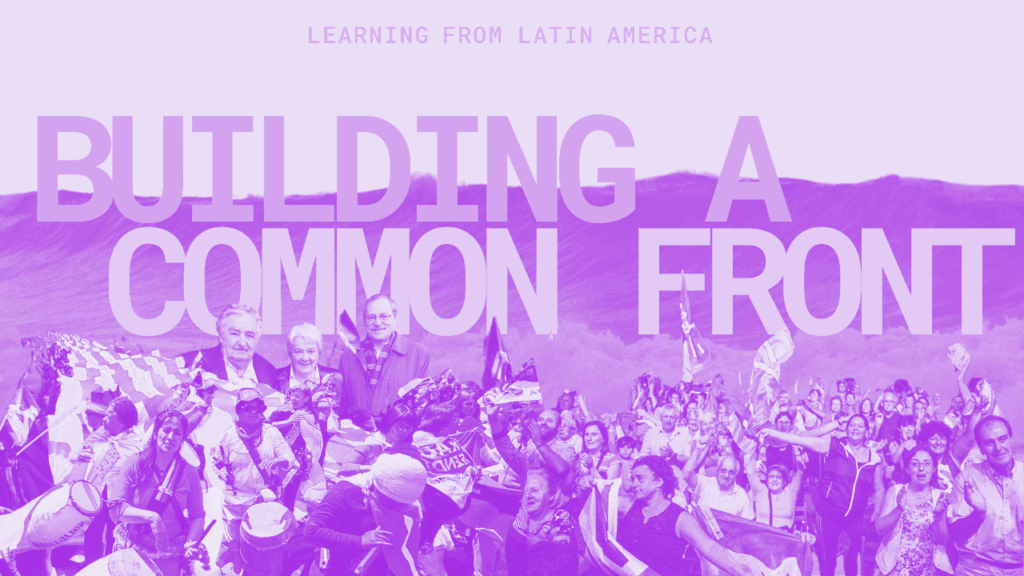§0. In All In, we write
“With the maturation of social movement literature and global interactions among activists and organizers, the term [social movement] has been gaining a deeper and more structured meaning. In a way, one could say that the movement is replacing the party.” (section §3.1.)
and a bit later we continue
“A global articulation of diverse lived experiences of capitalism is possible once we lift the movement into party category in the organizational sense. Equivalently, we are arguing that in a globally integrated capitalist system, the historical functions of the party will be fulfilled at the movement level and perhaps only at that level.” (section §3.1.)
Then, as if we didn’t just drop a bomb on theories of organizations, we move on to explore the actual implications of these statements. There are two reasons for this.
1) We have observed a shared intuition among movement organizers in the need of responding to complexity with complexity (class issue, global issue, with climate deadlines). So it is our assumption that if you share our frustrations and anxieties, the above statements will be less of an overwhelm and more of a relief.
2) Such a statement on organizational models is only comprehensible when we play with the model and explore how it would work out. So, rather than a theoretical justification, we show how we could use it. One can argue that this is the fallacy of appealing to consequences. Our take is that it is materialism: a model can only be “made sense of” in real life.
§1. Us not engaging with it in All In doesn’t mean there is no theory behind daring statements like ours above.
In fact, perhaps the most detailed and well-known such argument was developed by Rodrigo Nunes in his Neither Vertical nor Horizontal, published in 2021 by Verso Books.

In Neither Vertical nor Horizontal, Nunes goes into painstaking details and engages with decades of recent literature on social movements, organization and party models. Curiously, we wrote All In before our path crossed Neither Vertical nor Horizontal, so this short essay is an application article in the reverse sense: treating All In as application of the theory of organization presented by Rodrigo Nunes.
§2. Rodrigo Nunes makes an ontological case that any living organism (including social movements) presents itself ecologically, with different elements shaping, influencing and conditioning each other’s development. (This is also the descriptive starting point of All In, where we consider the movement ecosystem as a given.) Nunes thereby transforms a teleological question of into a strategic one. Quoting him directly,
“To replace a neurotic obsession with the One (unity, uniformity, identity) with a paranoid flight towards the Many (dispersion, incommunicability, differences as absolutes) is merely to invert the hierarchy of terms without questioning the assumption that there must be a single answer that applies to all cases and circumstances. The upshot is that a set of practical problems (what works? in what circumstances? to what end? at what cost?) is transformed into an abstract question with moralising overtones (what is right?).” [page 41]
Nunes further touches globalization [page 111], climate deadlines [page 97], the dead-ends of current theories of change [pages 116-117], which are all central to All In‘s problematique and makes it even more incredible that these books were written without any direct contact.
There are three topics highlighted by Nunes that directly interact with All In and that might deserve further attention.
§3. Vertical vs. Centralized: One of the main points of Nunes is that the movement is an ecosystem and we should therefore treat it as a network with distributed power relations (but not necessarily uniformly distributed). In other words, we never organize the totality, we always organize in it.
This is true, but sometimes Nunes seems to create an equivalence of Vertical=Centralized and Horizontal=Decentralized. This is valid for his argument, but for actual movement organizers these are different topics.
§3.1. Nunes is right that a movement is never vertical or horizontal. It will have vertical and horizontal elements in it, of different degrees, at all times.
Sometimes we start off with a lot of initial diversity that is somehow helpful for our strategic priorities, in which case we may decide appreciating horizontal aspects. Sometimes we need immediate and solid action, in which case vertical structures might be more effective.
A movement at a given moment might be in need of an element in it. The desired movement-function of this element would condition how vertical or horizontal it would need to be at a given moment.
§3.2. Nunes then talks about centralized or decentralized structures. This is a different level of abstraction. We are not looking at movement elements as units of investigation, anymore. Now we are looking at different elements and how they interact with each other.
Centralization is about how close different movement actors are to each other and how much formal interaction they have with each other.
Sometimes some elements in a movement ecosystem receive orders from other elements in the same ecosystem. This might be useful for coordinated rapid action. It might not be the most empowering for the participants of the submissive element, but those participants might still be motivated by efficacy.
Sometimes we need to harvest diversity and/or include many participants in their own terms; this would require more decentralized approaches.
§3.3. This distinction doesn’t matter for the point Nunes is making. But it matters for practical purposes.
When people complain about the “tyranny of structurelessness”, this has two sides: (1) hidden power relations within a collective and (2) implicit hegemony of an organization within the larger movement ecosystem.
We can want decentralized vertical organizations. Some labor union confederations operate like this most of the time: each labor union has a vertical structure, but the unions themselves are federated in their sector and confederated nationally without receiving a lot of orders from the central structures.
We can want centralized horizontal organizations. Many mass movements were initiated and maintained by an identifiable core leadership, who would be the guardians of the movement’s DNA. Everyone can be looking up to the leaders, while receiving no orders from them.
At the design stage of a new movement-level intervention, investigating the two question of vertical/horizontal and centralized/decentralized in a separate manner might reveal different aspects of what we are trying to achieve.
§4. Vanguard vs. Organizing Core vs. Leadership: Nunes also makes the important remark that no organization is a vanguard organization as such. An organization might fulfill a vanguard function at a given moment. He further defines another category, that of “organizing core”, which is (for all practical purposes) any intentional grouping that brings proposals into any collaborative space of the movement (it may be also making proposals to the entire movement).
Once again, these terms are valid and useful for the point Nunes is making. In fact, we specifically insist in “organizational materialism” as a starting point of any reasonable discussion.
And once again, from an organizer’s perspective, a clearer and wider understanding of leadership might be more useful.
We define leadership as making proposals, so a good leader would be the one who makes good proposals. A good proposal would satisfies a group’s purpose-needs (it takes the group closer to its goal) and the perceived/self-declared needs of its members (the members would find the proposal exciting and relevant).
Sometimes an organization needs cohesion, so a good proposal might be a conference, a training, a strategy retreat, a reading group, or an active-listening session (depending on the kind of cohesion needed). Proposing the adequate next step would be leadership.
Sometimes (after a victory or a defeat), a group might need to recover, reset, renew or reinvent its vision.
Sometimes a group of people leave a meeting and can’t decide where to go next. One person who suggests the pizzeria that accommodates everyone’s needs and preferences would be the leader of that moment.
This matters, because most of the times leadership is not at all about political direction. This limited concept of leadership hides the initiative, competence and work of people who hold processes and structures, and who do care work, manage conflicts or dedicate time for active inclusion efforts. These can be done at the organizational level by individuals. They can also be done at the movement level by specific organizations. These people and organizations are also leading their group and the movement.
This remark is not mere lip service to say that we should give visibility to all kinds of work being done. It is about movement-level interventions. A good proposal is always a proposal that pushes the movement towards its purpose(s) and which the movement actors find relevant and exciting. Sometimes, a dysfunctional movement might need a relieve and we must be able to identify that need in order to lead the movement to a better place. We will be able to identify it if our notion of leadership is attentive to such needs as well as political orientation.
§5. Another movement typology?: Underlying Nunes’ take on the relationship of the movement(s) and the organizations and individuals who are participating in it is perhaps an unstated proto-typology.
§5.1. To remind: In All In, we borrow three movement typologies from the literature: models of transformation, grand strategies, and movement capabilities. We use each to clarify different aspects of movement-level strategy and organization.
§5.2. With the discussion of the organizing cores and the vanguard party, Nunes seems to vaguely suggest yet another way of classifying movement actors. It is related to the relationship of an organization and its target group.
How much “consciousness” is supposed to be brought by the organization into its target group?
This question is, a priori, morally neutral. Bringing consciousness from outside doesn’t necessarily mean any imposition nor does it assume there is no consciousness inside. Sometimes it can just be bringing in factual information missing in the target group. Sometimes it may be ideological propaganda. Like any other movement activity, it can be done poorly or intelligently, patronizingly or emphatically.
Some community organizing efforts would part from the actual reality of the targeted communities. Some neighborhood work might start with specific preset goals of politicization. Different unions organizing in the same workplace might have different end-goals in mind. (Paulo Freire’s work on popular education gives depth and breadth to the dialectic process inherent in distinguishing levels of consciousness.)
§5.3. One could argue that the grand strategies (spontaneous uprising, mass agitation, ideological mobilization) also have this question in the background, but here we have a subtle difference worth mentioning. It’s not about how much participation (vs. how much consolidation) we aim for. It’s about the terms of the participation we are building.
So I identify here a possible future movement typology that can help us explore other aspects of the movement ecosystem in a systematic way.
***
Sinan Eden is a co-author of All In.
N.B. These “interaction” articles are book readings with specific angles. We have no intention of summarizing or reviewing the books. Rather, we are exploring interactions between the books’ content (main arguments or minor observations) and the movement-level strategy and organization framework presented in All In.








